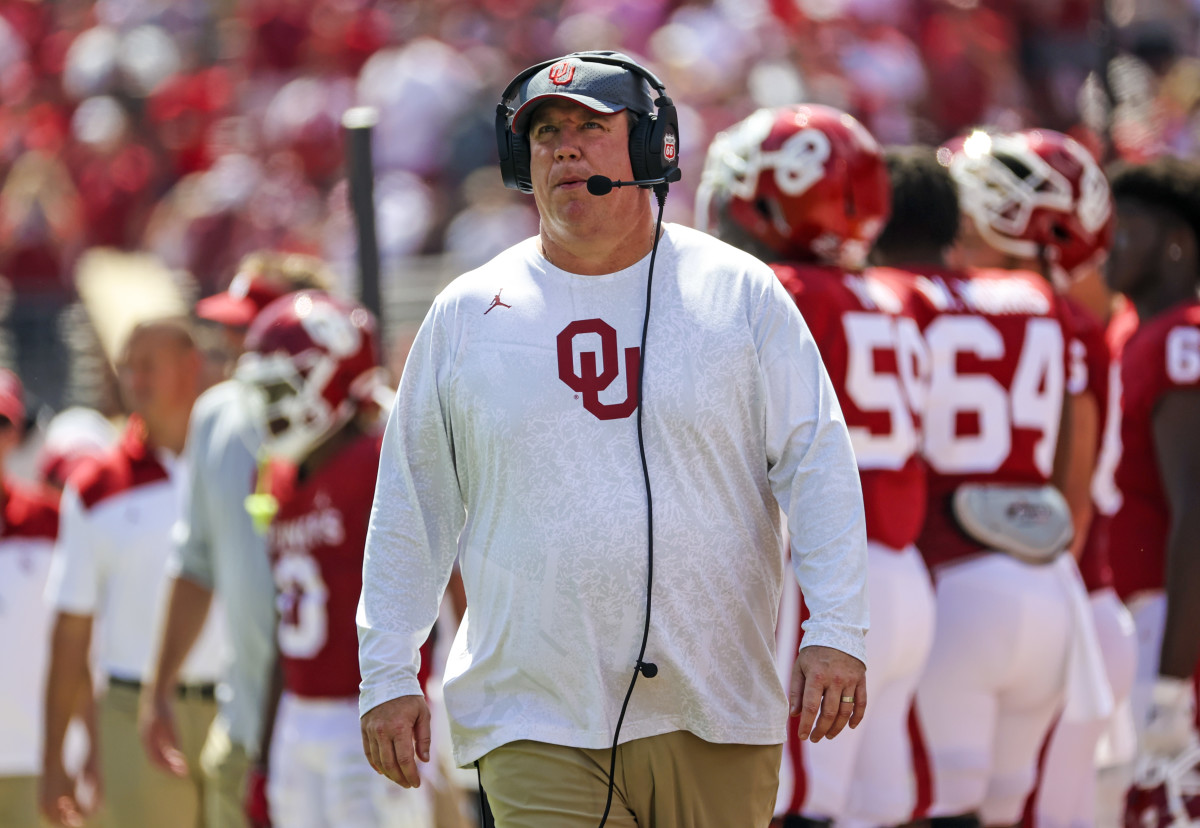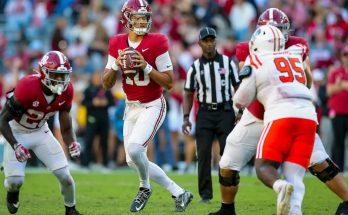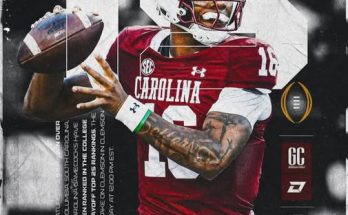Oklahoma football, historically one of the most dominant programs in college football, has weathered a tumultuous 2024 season that has seen its fair share of highs and lows. While the Sooners have maintained their competitiveness in the Big 12 and remained a program with a pedigree for excellence, one area has consistently hindered their progress—the offensive line. Despite a talented roster and explosive skill players, the offensive line became the Achilles’ heel for Oklahoma football in 2024, limiting the team’s overall potential and preventing them from achieving their usual success.
In a sport where the success of the offense often hinges on the performance of the offensive line, Oklahoma’s struggles in this area have reverberated throughout the entire season. From difficulties in protecting the quarterback to a lack of consistency in the running game, the offensive line’s shortcomings have been glaring. For Oklahoma, a program that has long prided itself on offensive prowess, this was an unexpected and disappointing reality. As we analyze the reasons why the offensive line became a liability for Oklahoma football in 2024, we’ll break down key factors such as player performance, coaching issues, recruiting challenges, and the broader implications for the team’s overall success.
The Struggles of the 2024 Offensive Line
The offensive line is often an unsung hero of any football team, but it is also one of the most vital components of an effective offense. When the offensive line fails to perform up to expectations, it can lead to a chain reaction of negative outcomes, ranging from a stagnant rushing attack to a quarterback under constant pressure. Oklahoma’s offensive line in 2024 struggled in several key areas, making it the primary reason for the team’s offensive inconsistencies.
Pass Protection Issues
One of the most significant problems the offensive line faced was its inability to protect the quarterback. Quarterback protection is crucial in any offense, and without a clean pocket, even the most talented signal-caller can be neutralized. In 2024, Oklahoma’s quarterbacks, despite being talented and experienced, were consistently under duress. The line allowed numerous sacks and pressures that disrupted offensive rhythm and forced the quarterbacks to make rushed decisions.
In particular, Oklahoma’s offensive line ranked near the bottom of the Big 12 in pass protection efficiency. With the Sooners often facing long third downs and long yardage situations due to failed first and second down runs, the lack of protection only exacerbated the problem. This made it difficult for Oklahoma to establish a consistent downfield passing game, which is essential in their fast-paced, high-scoring offensive system.
The pressure was particularly noticeable in critical games where the Sooners faced top-tier defenses. In matchups against teams like Texas and Kansas State, Oklahoma quarterbacks were under constant pressure, making it nearly impossible to sustain drives. Quarterbacks were forced into quick throws, often leading to incompletions or turnovers. As a result, the offense struggled to find a rhythm, and the passing game was not nearly as explosive as it had been in previous years.
Lack of Push in the Run Game
While Oklahoma has been known for its explosive aerial attack, the team has also relied on a strong rushing game to balance its offense. However, in 2024, the offensive line’s inability to generate consistent push in the run game severely limited the team’s ability to control the clock and dominate on the ground. Running backs found themselves frequently meeting defenders in the backfield, with little room to operate.
Oklahoma’s running game, which typically serves as a counterbalance to its high-powered passing offense, struggled to gain significant yardage in most games. The line’s lack of push at the point of attack was especially problematic when the team needed to convert short-yardage situations or grind out the clock in the second half of close games. In games where they faced physical teams with strong defensive lines, such as Baylor and TCU, Oklahoma’s running backs were consistently stuffed at the line of scrimmage, forcing the offense into predictable passing situations.
The inability to establish the run game placed additional pressure on the quarterbacks, who were already struggling with inconsistent protection. With the run game failing to develop, opponents could focus solely on pressuring the quarterback, knowing that Oklahoma was limited in its ability to run the ball effectively. The lack of balance between the run and pass game also made the offense easier to defend for opposing teams, as they could anticipate the Sooners’ play calling and adapt accordingly.
Inconsistent Line Play and Depth Issues
Another significant problem for Oklahoma’s offensive line in 2024 was a lack of consistency. Injuries, player performance, and lack of depth led to inconsistent play across the offensive line. The line was forced to shuffle players in and out of various positions, resulting in poor continuity and communication. While some individual players showed flashes of talent, the line as a whole lacked cohesion.
Oklahoma struggled to find a set starting five along the offensive line, leading to an ever-changing lineup throughout the season. This lack of continuity made it difficult for the offensive line to develop chemistry, which is essential for effective communication and execution, especially in pass protection. With different players starting each week, Oklahoma’s offensive line was never able to establish a consistent rhythm or form a solid unit capable of dominating opponents.
Additionally, depth issues became more pronounced as the season wore on. The lack of reliable backups to step in when starters were injured or ineffective contributed to the overall instability of the offensive line. As a result, Oklahoma was often forced to start less experienced or less effective players, leading to more struggles in pass protection and run blocking.
Coaching Challenges and Schemes
While the players’ performance on the field was a major factor in Oklahoma’s offensive line struggles, coaching decisions and schemes also played a significant role in the team’s struggles. In 2024, the Sooners’ offensive line coach, while experienced, was unable to turn around the unit’s performance. Coaching inconsistency, a lack of effective adjustments, and an inability to maximize the line’s potential contributed to the overall problems.
First, the offensive line’s technique and fundamentals were often criticized throughout the season. The lack of proper footwork, hand placement, and overall blocking technique led to defenders easily slipping past offensive linemen. Against top-tier defenses, Oklahoma’s offensive linemen were consistently outmanned and outwitted by opposing defensive line coaches who implemented more aggressive schemes. The Sooners’ offensive line was often overpowered in one-on-one matchups and unable to establish control at the line of scrimmage.
Moreover, the offensive line coaching staff failed to adjust to opposing teams’ defensive schemes. In games where opponents had strong pass rushers or overwhelming defensive lines, Oklahoma’s offensive line struggled to make adjustments, and the coaching staff did not implement effective countermeasures. For example, Oklahoma’s attempts to neutralize opponents’ pass rush with quick throws or play-action were often unsuccessful, as the defense would collapse the pocket too quickly, leaving no room for the quarterback to execute the play.
Additionally, the offensive scheme that Oklahoma ran in 2024 did not always play to the strengths of its offensive line. With a commitment to up-tempo play calling, the Sooners were often forced into hurry-up situations where the offensive line did not have the time to establish physical dominance. While this style of offense can be effective in certain situations, it put significant pressure on an offensive line that was already struggling to protect the quarterback and open running lanes.
Recruiting and Development Challenges
Oklahoma’s struggles along the offensive line in 2024 also highlighted challenges in recruiting and developing elite offensive line talent. While the Sooners have traditionally recruited well in other positions, the offensive line has not always been a strong point for the program. Recruiting highly skilled offensive linemen is a multi-year process, and in 2024, the lack of elite talent along the line was evident.
Oklahoma’s inability to develop top-tier offensive linemen in recent recruiting classes has put the program behind some of its competitors, particularly teams like Alabama, Georgia, and Ohio State, who have consistently fielded dominant offensive lines. While Oklahoma has some promising young talent on the offensive line, it’s clear that the program needs to invest more resources into developing elite offensive line talent if it hopes to compete at the highest levels in the coming years.
The Impact on Oklahoma’s Overall Performance
Oklahoma’s offensive line struggles had a profound impact on the team’s overall performance in 2024. The team’s inability to establish balance on offense made it difficult for the Sooners to compete against more physical teams in the Big 12. While they had explosive skill players at wide receiver and running back, the lack of protection for the quarterback and inability to move the ball on the ground consistently resulted in several disappointing losses.
The offensive line’s struggles also affected Oklahoma’s defensive performance. When the offense failed to sustain drives or convert third downs, the defense was left on the field for extended periods of time. This led to fatigue and, at times, poor defensive performances, particularly in close games. When the offense couldn’t score, the pressure mounted on the defense to keep the team in the game, and that pressure often proved to be too much.



